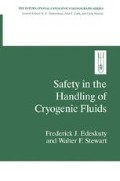Abstract
All cryogens can present the hazard of unwanted condensation of substances that boil at higher temperatures. Table 6.1 shows the estimated vapor pressures of some of the substances that, if present, can be condensed, usually to a solid, at cryogenic temperatures.1 From the magnitude of these vapor pressures it can be seen that, in some cases, even undetectable amounts of substances can be condensed, although probably only negligible quantities of solids could accumulate at such low concentrations. Table 6.1 indicates that any cryogen can almost totally condense water vapor and carbon dioxide. Air can be condensed to a liquid at liquid-nitrogen temperatures (possibly resulting in a condensate enriched in oxygen; see Section 6.1.2.). Argon, nitrogen, and oxygen are condensed to solids at the temperatures of liquid neon, liquid hydrogen, or liquid helium. Finally, all substances, other than helium, are solids at the temperature of liquid helium.
Access this chapter
Tax calculation will be finalised at checkout
Purchases are for personal use only
Preview
Unable to display preview. Download preview PDF.
References
Honig, R. E., and Hook, H. O. (1960). RCA Review 21, 360.
Edeskuty, F. J., Reider, R., and Williamson, K. D., Jr. (1971). Safety, in Cryogenic Fundamentals (G. G. Haseiden, ed.), pp. 633–672, Academic Press, New York.
Croft, A. J. (1971). Cryogenic fluids, in Advanced Cryogenics (C. A. Bailey, ed.), Chap. 2, Plenum Press, London.
Edeskuty, F. J. (1979). Safety, in Hydrogen: Its Technology and Implications (K. E. Cox and K. D. Williamson, Jr., eds.), Vol. IV, Chap. 5, CRC Press, Boca Raton, Florida.
Stewart, R. B., and Johnson, V. J. (1961). A Compendium of the Properties of Materials at Low Temperatures (Phase II), WADD Technical Report 60-56, Part IV, United States Air Force, Wright-Patterson Air Force Base, Dayton, Ohio.
Author information
Authors and Affiliations
Rights and permissions
Copyright information
© 1996 Springer Science+Business Media New York
About this chapter
Cite this chapter
Edeskuty, F.J., Stewart, W.F. (1996). Condensation. In: Safety in the Handling of Cryogenic Fluids. The International Cryogenics Monograph Series. Springer, Boston, MA. https://doi.org/10.1007/978-1-4899-0307-5_6
Download citation
DOI: https://doi.org/10.1007/978-1-4899-0307-5_6
Publisher Name: Springer, Boston, MA
Print ISBN: 978-1-4899-0309-9
Online ISBN: 978-1-4899-0307-5
eBook Packages: Springer Book Archive

